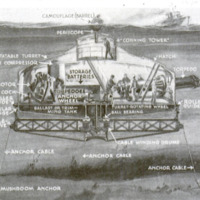Submersible fort
Contenuto
-
Titolo
-
Submersible fort
-
Article Title and/or Image Caption
-
Submersible Forts to Protect Our Costs. They are conceived as anchored, floating turrets, capable of discharging torpedoes at the enemy's ships
-
extracted text
-
IT is a short time before sunrise. The sea is fairly calm and reflects in undulating patches the gorgeous colors of the sky already visible in the East. The rhythmic sound of a whirling propeller is faintly audible. It is still far away, but approaching rapidly.
Fifteen minutes later the graceful yet forbidding form of a warship emerges from the light morning mist. It is an enemy raider headed for the roadway to one of America’s important Atlantic ports.
On board the hostile ship the tension is great. There may be mines and submarines, coast batteries and other defences. The deck watches have seen nothing suspicious and cautiously the raider continues its way toward the roadway.
The hostile craft has just passed a few hundred yards from a piece of wreckage, a waterlogged barrel, when the watcher notices a sharply defined line of bubbles rapidly approaching the ship.
“Torpedo coming, look out!” he yells with all his might. It is too late. Before the course of the ship can be changed the torpedo strikes amidships. A tremendous explosion makes the water rise like a fountain and descend again upon the shattered and fast sinking hull of the ship. A few moments later all is over.
The torpedo, which was launched from the tube of a submersible anchored fort, the periscope of which was camouflaged by the barrel, has done its work.
An episode like that pictured here, in brief, would be entirely within the range of possibility, should the government adopt the idea of a submersible fort in accordance with the invention by J. A. Steinmetz of Philadelphia, recently patented. The fort, in the form of a turret, provided with a conning tower, may be submerged altogether or only so far that the conning tower is visible. It is the plan of the inventor to anchor such forts along the coast and near harbor entrances as a protection against hostile ships. The mechanism for winding and unwinding the anchor cables, for turning the turret upon the ball-bearings of its anchored base and for launching the torpedoes is controlled from inside the turret and storage batteries supply power for the air pumps, and for lighting the crew's quarters. For cases of emergency a supply of compressed air is stored in a pressure tank in the turret. The forts would be self-contained and would carry sufficient supplies to enable them to carry on between the periodical visits of a supply ship.
-
Autore secondario
-
A. Steinmetz (inventor)
-
Lingua
-
eng
-
Data di rilascio
-
1918-04
-
pagine
-
512-513
-
Diritti
-
Public Domain (Google digitized)
-
Archived by
-
Filippo Valle
-
Alberto Bordignon (Supervisor)
 Submersible fort
Submersible fort